Variable Structure Disturbance Rejection Control for Nonlinear Uncertain Systems with State and Control Delays via Optimal Sliding Mode Surface Approach
Abstract
The paper considers the problem of variable structure control for nonlinear systems with uncertainty and time delays under persistent disturbance by using the optimal sliding mode surface approach. Through functional transformation, the original time-delay system is transformed into a delay-free one. The approximating sequence method is applied to solve the nonlinear optimal sliding mode surface problem which is reduced to a linear two-point boundary value problem of approximating sequences. The optimal sliding mode surface is obtained from the convergent solutions by solving a Riccati equation, a Sylvester equation, and the state and adjoint vector differential equations of approximating sequences. Then, the variable structure disturbance rejection control is presented by adopting an exponential trending law, where the state and control memory terms are designed to compensate the state and control delays, a feedforward control term is designed to reject the disturbance, and an adjoint compensator is designed to compensate the effects generated by the nonlinearity and the uncertainty. Furthermore, an observer is constructed to make the feedforward term physically realizable, and thus the dynamical observer-based dynamical variable structure disturbance rejection control law is produced. Finally, simulations are demonstrated to verify the effectiveness of the presented controller and the simplicity of the proposed approach.
1. Introduction
Various approaches have been proposed to solve disturbance rejection problems, such as H∞ control [1], adaptive control [2], internal model control [3], variable structure control (VSC) [4], and optimal control [5–7]. Optimal disturbance rejection appears in a variety of applications, vehicle engine [5], damped systems [6], and spacecraft attitude control [7], for instance. However, in reality, the factor of nonlinearity, uncertainty, or time delay exhibits much influence on practical system [8–19], especially on today’s large information communication system. The factor of nonlinearity, uncertainty, or time delay leads the system and computation to be more complex and difficult to calculate. In addition, it brings discrepancy between the real parameter and the precise one. Therefore, it is necessary to take account of nonlinearity, uncertainty, or time delays in system modeling. In recent years, these issues have been given many attention; for example, see [1, 8–30]. Moreover, there are series techniques appeared to design controllers for such systems. Seeing that it is not an easy work to solve one of these problems, say nothing of concentrating on all of these issues. This study explores a disturbance rejection control design for a nonlinear uncertain time-delay system using the variable structure control approach, for the reason of VSC’s insensitivity to a wide class of uncertainties or disturbances [4, 8, 12, 13, 16, 30–34]. In previous VSC investigations, some reports gave the solutions for uncertain or nonlinear systems, for example, [8, 30, 34]; some gave for the time delay systems [12, 13]; but few appeared to focus on systems of both nonlinear uncertain and time-delay. This paper is different from these bodies of literature. It presents a relative simple VSC solution to a nonlinear uncertain and time-delay system.
It is based on the ideas of the approximating sequence method [25–27] and the finite spectrum assignment approach [20–22]. The contributions of this study are as follows: firstly, the functional transformation method is applied, which transforms the time-delay system to a delay-free one and reduces the original problem from an infinite-dimension space to a finite-dimension one; subsequently, the optimal sliding mode surface (OSMS) is designed by using approximating sequence method, which simplifies the nonlinear OSMS design problem to a linear two-point boundary value (TPBV) one; furthermore, the corresponding compensators are designed in the variable structure disturbance rejection control (VSDC) so that the nonlinearity, uncertainty, and the time-delay effects are entirely compensated consequentially; moreover, the disturbance effect is reduced by the feedforward compensation term; additionally, to realize its physical implementation, a reduced-order observer is constructed to reconstruct the disturbance state vectors, and thus the observer-based dynamical VSDC is produced; finally, the designed VSDC is employed to a quarter-car suspension model which possesses the nonlinear, uncertain, and time-delay properties, and by comparing the system responses with the open-loop system (OLS), the effectiveness and the simplicity of the designed control are demonstrated.
This paper is organized as follows. After an introduction, in Section 2, system description is done. The OSMS and the corresponding VSDC in finite-time horizon are designed in Section 3. In Section 4, the infinite-time horizon ones are given. In Section 5, numerical simulations are illustrated. Concluding remarks are given in Section 6.
2. System Descriptions
Assumption 1. It is assumed that system (1) is spectral controllable.
In system (1), v(t) ∈ ℝq is the external disturbance input whose dynamical characteristic is known and can be described by the following exosystem:
In what follows, we will reduce the controller design problem of original system (1) to that of a delay-free one referring to the method proposed in [20] which applied this method to a linear time-delay system. Now, we develop it to the nonlinear time-delay system (1).
Notice that system (5a) and (5b) is coupled with y and x(y). Indeed, the term f(x, t) is nonlinear. From the previous investigations, it can be seen that by the functional transformation method [20–22], y is admissible to system (5a) and (5b) if and only if x is admissible to system (1). Moreover, the controller stabilizing (1) also stabilizes (5a) and (5b). Based on this idea, in what follows, we will develop this approach to solve the VSDC problem of system (1) through the equivalent delay-free system (5a) and (5b).
Thereby, we will demonstrate the control law design process of finite-time horizon and infinite-time horizon in Sections 3 and 4, respectively.
3. Design of VSDC in Finite-Time Horizon
This section is to outline the sufficient and necessary condition for the optimality of an optimal sliding mode surface s*(t) subject to the nonlinear dynamical constraint (9a) and (9b). In what follows, we will give the design procedure in two steps: OSMS design and VSDC design.
3.1. Design of OSMS in Finite-Time Horizon
3.1.1. Global OSMS of Nonlinear Systems
Consider the optimal control problem (9a) subject to (12), treating f1(x, t) as an excitation term despite its relationship with y. Thus, the main result of Theorem 2 is achieved.
Theorem 2. Consider the optimal sliding mode surface design problem described by system (1) under disturbance (2) with quadratic performance index (12). The optimal sliding mode surface is existent and unique which is given by
Proof. In analogy to classical linear quadratic regulator optimal control theory from minimum principle, the Hamiltonian for the linear-quadratic control problem (9a) with respect to (10) and (11) becomes
From (21), it shows that the costate λ has linear relationship with state z1(t). Thus, denote the costate vector
From (23) and (26), it follows the optimal virtual control
Matrix differential equations (14)–(16) satisfy the conditions of existence and uniqueness which implies that the OSMS (13) is existent and unique. The proof is completed.
3.1.2. Approximations of Sequences of State and Costate Equations
In what follows, with the purpose of proving sequences {g(k)} and , {x(k)} converge to the solution of (16) and (17), and some preliminaries should be carried out.
-
(A1) ∥h(t, x)∥ ≤ γ, for all x ∈ ℝn,
-
(A2) , for all x1, x2 ∈ ℝn, where γ is some finite constant and .
Secondly, we will prove approximating sequences (38) convergent to the solution of (37). As a result, Lemma 3 is available.
Lemma 3. Let h(t, x) satisfy (A1) and (A2). Then, the limit of the solution of the approximating sequences (38) on C([t0, tf]; ℝn) converges to the unique solution of (37) on [t0, tf].
Proof. Let
Thirdly, result of (38) and (37) described by Lemma 3 directly carries out the same result of (32)–(35) and (16)-(17) described by Lemma 4.
Lemma 4. Let f1(x, t) be bounded and Lipschitz continuous in its arguments. Then, the limits of the solutions of the approximating sequences (32) and (33) (or (34) and (35)) on C([t0, tf]; ℝn) globally converge to the unique solutions of (16) and (17), respectively, on [t0, tf].
Last but not least, the main result of OSMS by approximation sequences is got as Theorem 5.
Theorem 5. Given the nonlinear system (1) and the cost functional (12), then the optimal sliding mode surface is given by the limit of the sequence
Remark 6. Actually, in practice, the limit of lim k→∞ g(k) can be obtained by replacing ∞ with a positive integer M. Relevantly, the following suboptimal sliding mode surface is achieved:
Consequently, we give the algorithm of OSMS.
Algorithm 7. OSMS of system (1).
3.2. Design of VSDC in Finite-Time Horizon
In this section, we will present the VSDC design of finite-time horizon based on the proposed OSMS in the last section.
3.2.1. VSDC Design
Theorem 8. Consider system (1) under disturbance (2) with quadratic performance index (12). The sliding mode surface is given by (13). Then, the state trajectories can reach the sliding mode surface in finite time and remain on it by the variable structure control law:
Proof. Differentiating sliding mode surface (29) with respect to time and substituting system (9a) and (9b) into it give
Besides, the reachable condition (54) is verified in what follows. Substituting the VSDC (58) into (56) gives
Remark 9. Actually, for the reason in Remark 6, the suboptimal sliding mode surface (SOSMS) (49) can be applied in practice. Thus, the relevant VSDC for SOSMS (49) can be gotten:
3.2.2. Closed-Loop Stability Analysis
Select the OSMS function s(z) as a Lyapunov function candidate, that is, V(z) = (1/2)s2(z). Then, the increment of it is . As known, the OSMS satisfies the reachable condition (54), that is, . Thus, is negative definite, which implies limt→∞ z(t) = 0. Moreover, from (3) and (8), it can be proved that x → 0 as z → 0 indicating the closed-loop system states asymptotically stable.
3.2.3. Physical Realization of VSDC
The VSDC u*(t) in (55) contains disturbance state w(t) which is physically unmeasurable. To solve this problem, one can construct a reduced-order observer for disturbance vector so as to reconstruct the disturbance variables [28, 29, 35].
Theorem 11. Consider system (1) under disturbance (2) with quadratic performance index (12). Respecting the sliding mode surface (13), the dynamical sliding mode control law is given
Proof. Defining the nonsingular transformation
Now, the problem is converted into finding the observer gain L such that error system (76) is asymptotically stable. That the pair (G, F) is observable ensures the pair (FGΠ2, HGΠ2) observable; thus there exists the gain L such that all eigenvalues of matrix (H − LF)GΠ2 can be assigned to the desired position in left-half plane, which guarantees error system (76) exponentially stable. It implies limt→∞ew(t) = 0, that is, . Hence, rewriting VSDC (57) by replacing the disturbance state w by the estimated state of (75):
At this time, the VSDC design in finite-time horizon is completed. In the next section, we will discuss the corresponding results of infinite-time horizon.
4. VSDC Design in Infinite-Time Horizon
Then, our object is to design OSMS and VSDC with respect to performance index (78) and (79) subject to dynamic constraint (9a) and (9b).
In reality, when tf → ∞, the time-variable matrices P1(tf) and P2(tf) of finite-time horizon approach to some constant matrices denoted by P1 and P2, respectively, that is, and [35]. Therefore, the results of the infinite-time horizon can be directly obtained from those of the finite-time horizon. Yet, for the sake of briefness, the corresponding results are omitted here.
5. Simulation Example
| Variable | Value | Unit |
|---|---|---|
| ms | 350 | kg |
| mu | 59 | kg |
| k1s | 14500 | N/m |
| k2s | 160000 | N/m |
| kt | 190000 | N/m |
| bs | 1100 | N · s/m |
Then, transform the system in the form of (9a) and (9b). To simulate the road profiles, two cases of sinusoidal signal and attenuated signal are employed.
Case 1. Consider sinusoidal disturbance described by exosystem (2) with
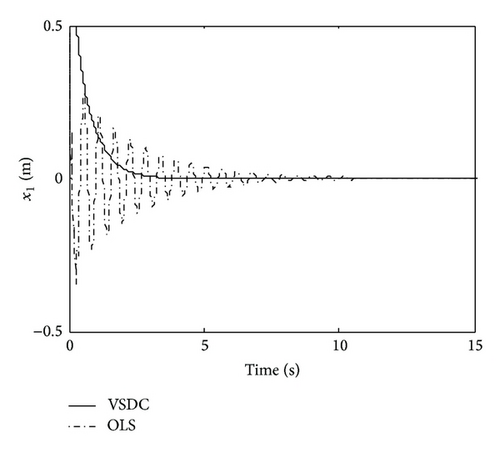
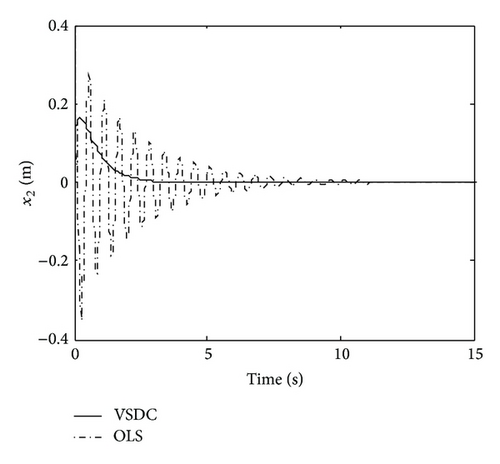
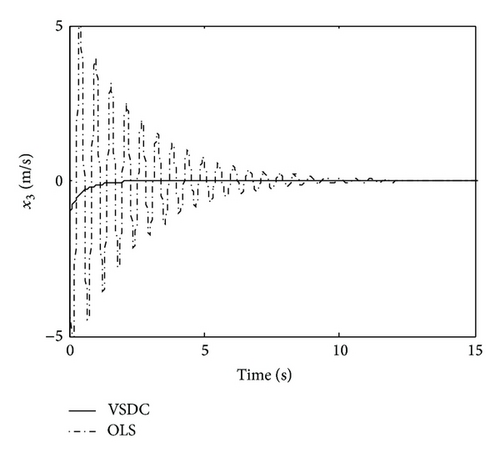
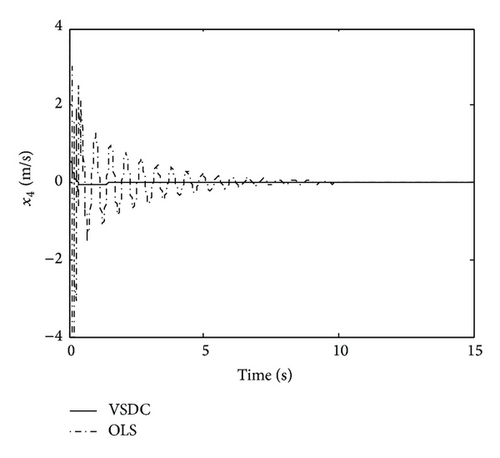


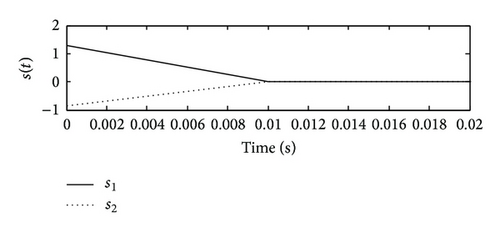
From Figure 1, it can be seen that the states are stabilized and become stable by using VSDC and the magnitudes of the suspension response are obviously reduced comparing with those of the OLS. The reason can be concluded from Figure 2, that by using VSDC, the states were controlled towards the OSMS; while being forced onto the OSMS, the equivalent control ue drove them stabilized and hold good dynamical characteristics.
Case 2. Consider attenuated disturbance described by exosystem (2) with
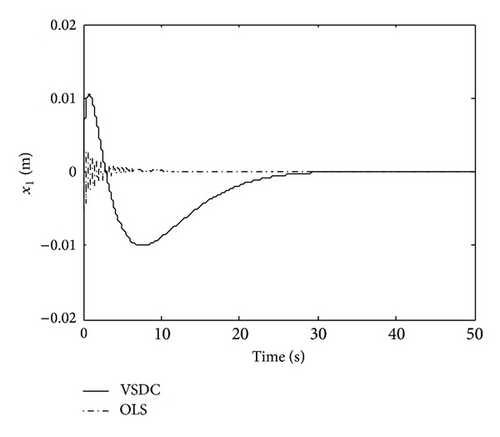
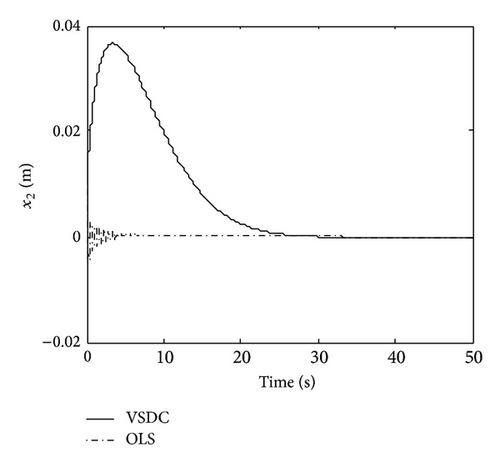
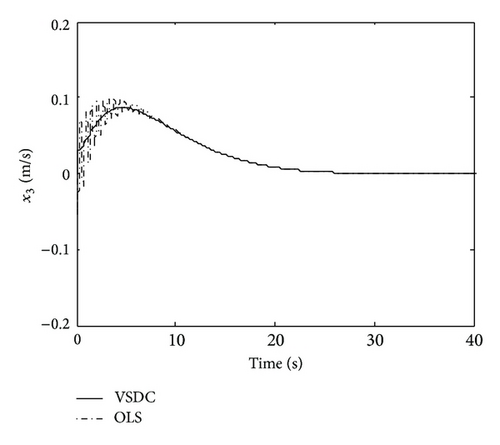
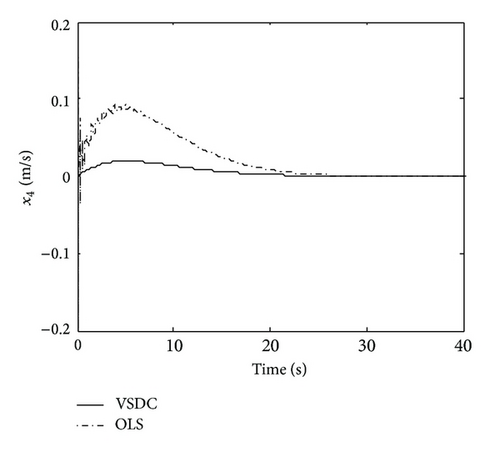


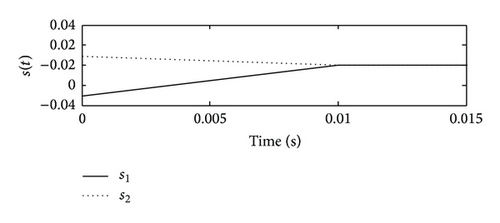
It is shown that the state variables are reduced by VSDC comparing with OLS, which are controlled asymptotically stable at about 30 sec. Clearly, the VSDC rejected the disturbance which is faced by the system and makes the state variable of OLS vibrate.
Summarily, comparing the simulation results between Figures 1 and 2 and Figures 3 and 4, we can see that, although the states are reduced by VSDC and lower than those of OLS when facing sinusoidal disturbance, it still vibrates a little; whereas when facing attenuated disturbance, they converge to zero gradually. The reason lies in the main different feature of these two kinds of signals. Notice that in VSDC (55), there exists the feedforward compensation term described as , which causes the closed-loop system to still be affected by disturbance w(t). For this reason, facing sinusoidal disturbance, the VSDC is able to compensate the effect generated by disturbance so that the state amplitudes are reduced but is not able to eliminate it entirely; while when facing attenuated disturbance, the disturbance effect can be entirely eliminated and state variables approach zero. In addition, the sinusoidal and random disturbances can be entirely eliminated by using dynamic internal-model compensator, which can be referred to some bodies of literature, for example, [35] or our previous studies [28, 36].
6. Conclusions
In this paper, the variable structure disturbance rejection strategy for nonlinear systems with uncertainty and time delay is presented. The original system has been transformed into the delay-free one as well as the optimal problem has been reduced to that of lower dimensions. The designed OSMS and VSDC in both finite-time and infinite-time horizon are proposed, where the disturbance is reduced and the uncertainty and the nonlinearity are entirely compensated. Numerical simulations have demonstrated the effectiveness of the designed control law as well as the simplicity of the proposed approach. It is verified that this proposed approach is easy to implement and of reduced complexity.
Conflict of Interests
The authors declare that there is no conflict of interests regarding the publication of this paper.
Acknowledgments
This work is partially supported by the National Natural Science Foundations (61364012, 11361076), the China Scholarship Council Foundation (201208535084), the Natural Science Foundation of Yunnan Province (2011FZ169), the Key Program of the Scientific Research Foundation of the Education Department of Yunnan Province (2013Z034), and the Open Fund of Key Laboratory in Software Engineering of Yunnan Province (2011SE15). The authors would like to thank Editor Valery Y. Glizer and the Reviewers for their careful review and significant comments improving the presentation of this paper.




